Scotland Performs Update
Scottish Government performance information
Rural Economy and Connectivity Committee
Scorecard
The following National Performance Framework indicators have been selected as relevant to the Rural Economy and Connectivity Committee for the purposes of the Draft Budget Consultation Period.
The report overleaf shows recent performance on these indicators as at 14 December 2017.
The hyperlinks take you to the Scotland Performs website for the latest information on each indicator.
Performance Improving
To rank in the top quartile for productivity against key trading partners in the OECD by 2017
Increase real terms productivity in Scotland
Increase the number of businesses
Improve digital infrastructure
Performance Maintaining
To raise the GDP growth rate to the UK level by 2017
To maintain our position in labour market participation as the top performing country in the UK
To narrow the gap in participation between Scotland’s best and worst performing regions by 2017 ( cohesion)
To reduce emissions by 42% by 2020 and 80% by 2050 ( sustainability)
Reduce traffic congestion
Increase the proportion of young people in learning, training or work
Improve people’s perceptions of the quality of public services
Reduce children’s deprivation
Improve people’s perceptions of their neighbourhood
Increase cultural engagement
Improve the condition of protected nature sites
Increase the abundance of terrestrial breeding birds: biodiversity
Increase natural capital
Improve the state of Scotland’s marine environment
Reduce Scotland’s carbon footprint
Increase the proportion of journeys to work by public or active transport
Performance Worsening
Improve the skill profile of the population
Reduce deaths on Scotland’s roads
Reduce the proportion of individuals living in poverty
Increase renewable electricity production
Performance Improving
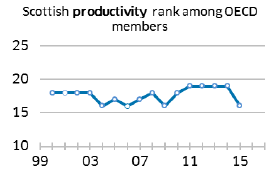
Scotland's productivity rank remained at 19 out of 36 countries between 2011 and 2014, at the top of the third quartile. In 2015, the rank rose to 16 out of 36.

Scotland’s productivity increased by 3.5% in real terms during 2015. It is now 9.4% higher than the pre-recession level in 2007.

The number of businesses per 10,000 adults has increased over recent years and is now at a series high level.

Next generation broadband was available at more premises in 2016 than in the previous five years.
Performance Maintaining

Scotland’s annual GDP growth rate, on a 4Q on 4Q basis, was lower than the comparable UK rate in the first and second quarters of 2017.
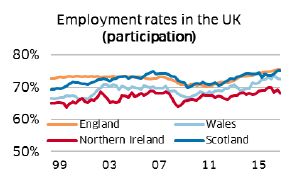
Scotland's employment rate was the second highest in the UK in the second and third quarters of 2017.
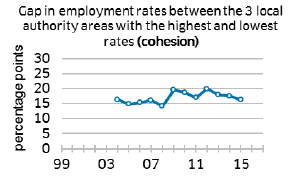
The gap in employment rates between the three local authorities with the highest and lowest rates has declined steadily since 2012.
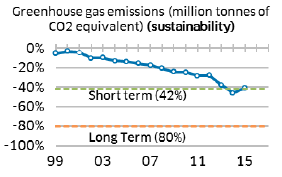
In 2015, Greenhouse gas emissions were 41% lower than the Baseline Period. This is outperforming on the percentage reduction trajectory required to meet the 2020 target (42%) and the 2050 target (80%).
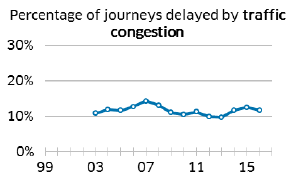
Journeys perceived to have been delayed due to traffic congestion fluctuated between 2007 and 2016.
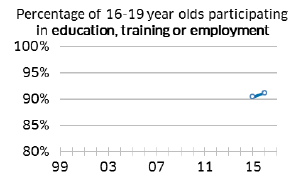
The percentage of 16-19 year olds participating in education, training or employment increased between 2015/16 and 2016/17.
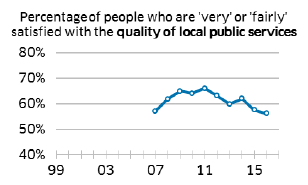
The percentage of people who are 'very' or 'fairly' satisfied with local public services remained stable between 2015 and 2016, having decreased since 2011.
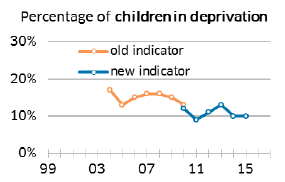
The percentage of children living in material deprivation remained stable between 2014/15 and 2015/16. In 2010/11, there was a change to the questions asked in the survey.
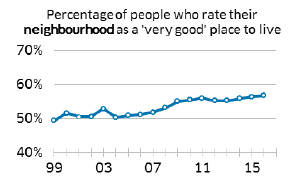
The percentage of people who rated their neighbourhood as a ‘very good’ place to live increased between 2006 and 2011, but has remained stable since.
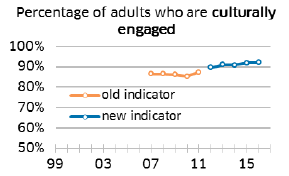
The percentage of adults who engaged in a cultural activity remained stable between 2012 and 2016. The survey question was changed in 2012. Previously the percentage had remained fairly stable since 2007.
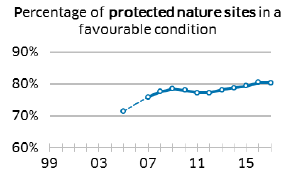
The proportion of protected nature sites in a favourable condition remained stable in 2016, part of a gradual upward trend.
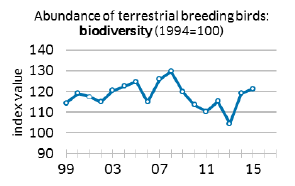
The abundance of terrestrial breeding birds remained stable between 2014 and 2015, following a large increase in 2014.

The Natural Capital Asset Index has remained about the same for the last decade and is roughly at the same level as in 2000.
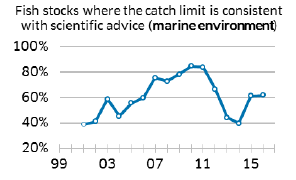
The percentage of fish stocks where the catch limit is consistent with scientific guidance remained stable between 2015 and 2016, following a sharp increase in 2015.

Scotland’s carbon footprint has remained stable since 2011, following a declining trend since the peak in 2007.
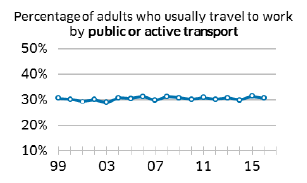
The proportion of adults who usually travel to work by public or active transport has remained stable for the last decade.
Performance Worsening

The percentage of the working age population with low or no qualifications has steadily declined since 2004, despite the increase in 2016.
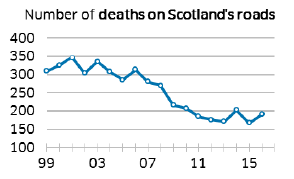
The number of people killed on Scotland’s roads has fluctuated in recent years. However, this continues to follow a long term downward trend.
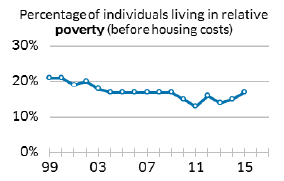
The proportion of people living in relative poverty increased in 2015/16 and has fluctuated since 2009/10.

The proportion of Scotland's electricity generated from renewable sources has been increasing fairly steadily since 2003, despite the decrease in 2016.
Contact
There is a problem
Thanks for your feedback